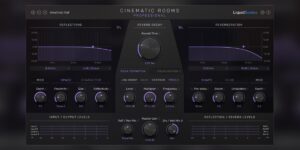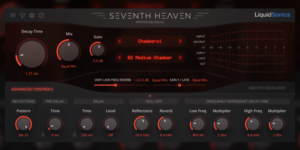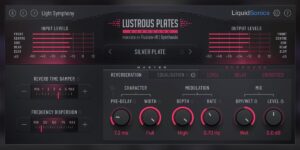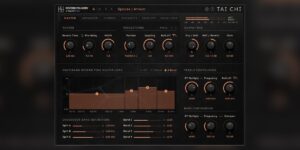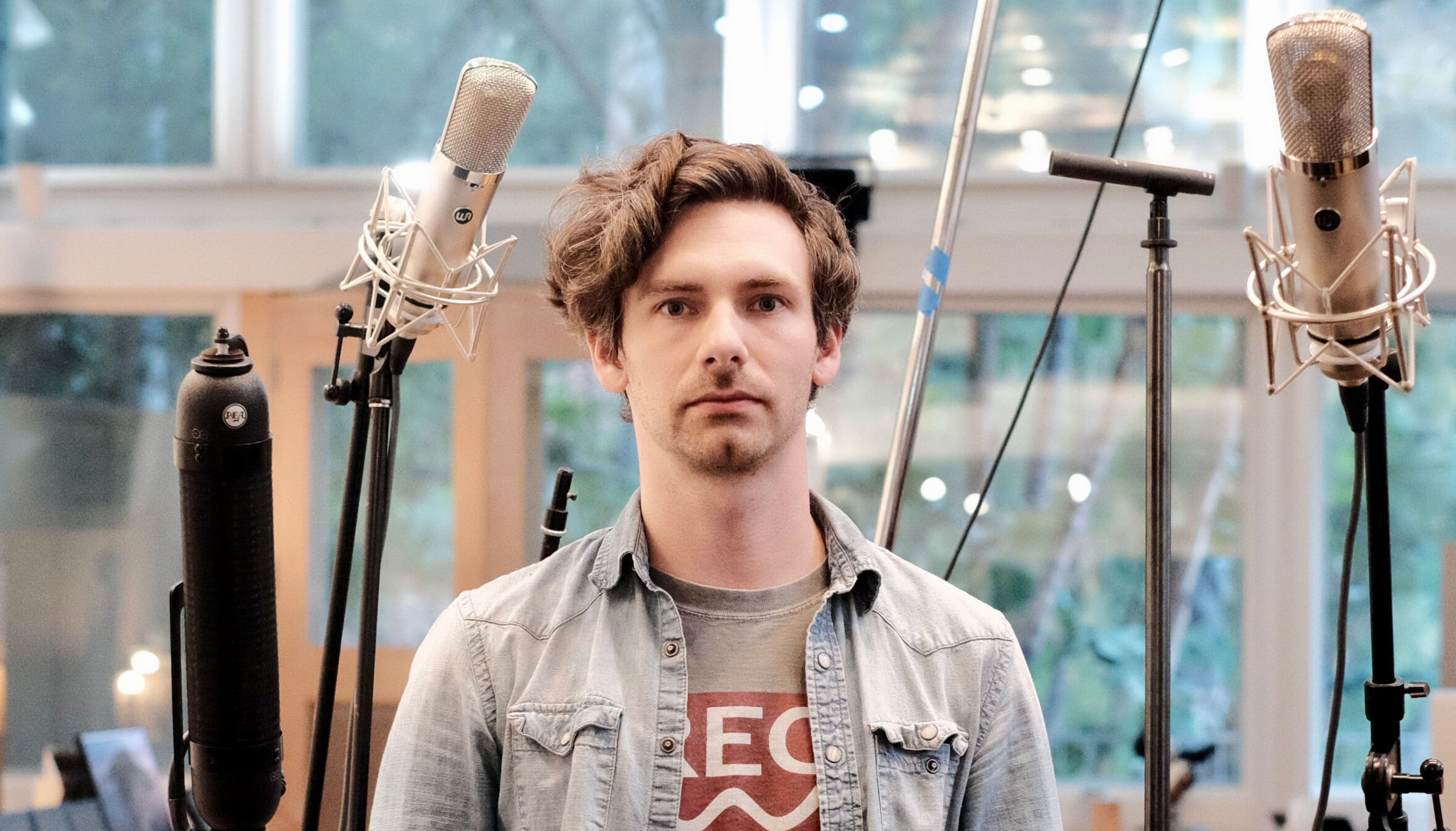
From a child living in a small town in Louisiana to in-house engineer at John Powell’s esteemed 5 Cat Studios in Hollywood, John Michael Caldwell’s journey to professional heights always had music at its core. His roster of impressive TV and film credits include M3gan, Ice Age, Still – The Michael J Fox Story and the forthcoming Illumination animated move Migration, to name a few.
Openly admitting he wasn’t always sure about the direction in which he wanted to head, John tells us about his voyage to becoming a renowned score mixer, what it’s like working with John Powell, imposter syndrome, and how LiquidSonics reverbs fit into his workflow.
Let’s start at the beginning, tell us about the first stages of your musical journey…
My mum played piano when I was a kid and made me take piano lessons so maybe that was my first start and then I joined the band in middle school. My brother played trombone at school and I always thought that maybe I would play a wind instrument or something, but, at the time, I had braces and they give you these little wax strips to put on the front of your braces so that your lips don’t bleed or get too bothered by the braces and it just bothered me too much. So, I was like, you know what, I’m just going to play the drums, and then I just stuck with it. I got started doing that and playing in the marching band and then went to college and played in the band there and studied classical music and majored in music education.
While in high school, I started just recording as much as I could because I wanted a way to mess around with things and figure stuff out and listen to myself play stuff back. Some of my friends were musical, so we always wanted to record ourselves and write songs for our girlfriends.
In middle school, I begged my parents to buy me a little four track Tascam recorder, it was a Portastudio, a little cassette thing. As time progressed, I ended up getting a Dell computer from my brother whenever he bought a new computer and then I upgraded to Sonar Cakewalk. It was a big thing at that time and it was the only thing I could really figure out how to use. I also got a little cheap interface, like Nady preamps when I was in high school, and then I started recording other bands and stuff.
I never really saw it as something that I would get into full time. I always thought I was going to be a drummer and stay a percussionist and always perform – one of the big things I wanted to do was be in the Blue Man Group. It progressed to a point where I got into college, I was majoring in music and I was doing more performing because of my major.
I became more of a behind the scenes person and not really wanting to be a performer – even though I still enjoyed playing, I just didn’t like being in front of the audience. I ended up dropping out of college after two years and that’s when I decided I wanted to do recording and engineering and I found the Recording Workshop in Chillicothe, Ohio. I went through that program and then went to Dubway. After that my mum found a studio that was an hour and a half from the town we grew up in in Northeast Louisiana, Monroe. It was called Blade Studios and it was being opened by this guy named Brady Blade, a drummer whose credits extend to Dave Matthews Band and Jewel. He was getting a guy named Chris Bell to be the chief engineer at the studio so I sent them my resume and got called in to interview. I ended up getting hired. I was super nervous about that. It’s probably the most nervous I’ve ever been in my life, trying to get that job. It was a super great experience working at that studio because they hadn’t even built it yet so Chris was still buying all of the gear.
We were in old biochemical engineering buildings with these labs upstairs and it was being turned into a creative space. Russ Berger was doing the design for the studio – when I started they were still pouring the concrete! Then some guys came out from LA to run the wires and little by little, it turned into the studio that it became with an SSL Duality, tons of great outboard gear, great sounding rooms. I still today feel like it’s one of the best sounding rooms I’ve been in. That live room was amazing and those drums sounded amazing in that studio. I think Russ did a really great job with his designs.
We worked on a lot of stuff like Andy Timmons, Chuck Rainey, (Aretha Franklin’s bass player) – we recorded his solo album at that studio. Brian Blade, who is Brady Blade’s drummer, came and recorded there which was great because he was a person that I always looked up to as a drummer.
I decided to go back to school to finish my degree and then my girlfriend at the time, who’s my wife now, got accepted into vet school, down south in the state college at Louisiana State University. So, we went down to Baton Rouge and I dropped out of college again before I finished my degree – I think I was just in a limbo state, I wasn’t really sure what I wanted to do.
I started engineering for television for a guy named Jimmy Swaggart, who is a really popular, big time, televangelist. I wanted to do some stuff in engineering but I still wanted to make money while my wife was in college. Being freelance didn’t make sense because I didn’t have a roster of clients that would stick with me, I was still a nobody from a small studio up north in Louisiana.
I started getting into music for film and stuff like that and then I got it into my head that Los Angeles was the place to be. So, after my wife Alexis graduated, we moved out to LA in 2018 and that’s when I started working for John Powell and things came to fruition. I started doing more and more recording and more and more mixing and I’ve made it to where I am today, at least.
Do you think it was John Powell that was the tipping point?
Yeah, it was definitely a catalyst being at John’s studio and learning so much. Learning how composers set up their studios, how routing was done and seeing a team like Shawn Murphy’s team mix John’s music.
I saw and observed Shawn’s team mixing John’s films for How To Train Your Dragon, The Hidden World and Call Of The Wild, and that was super useful. I also got to see Erik Swanson, how he works and sets up Pro Tools and the templates for Shawn and how Shawn does the mixing and then how David Channing comes in and edits everything together. That was super useful and gave me a lot of knowledge in how to just run a mix and how to get it from point A to point B.
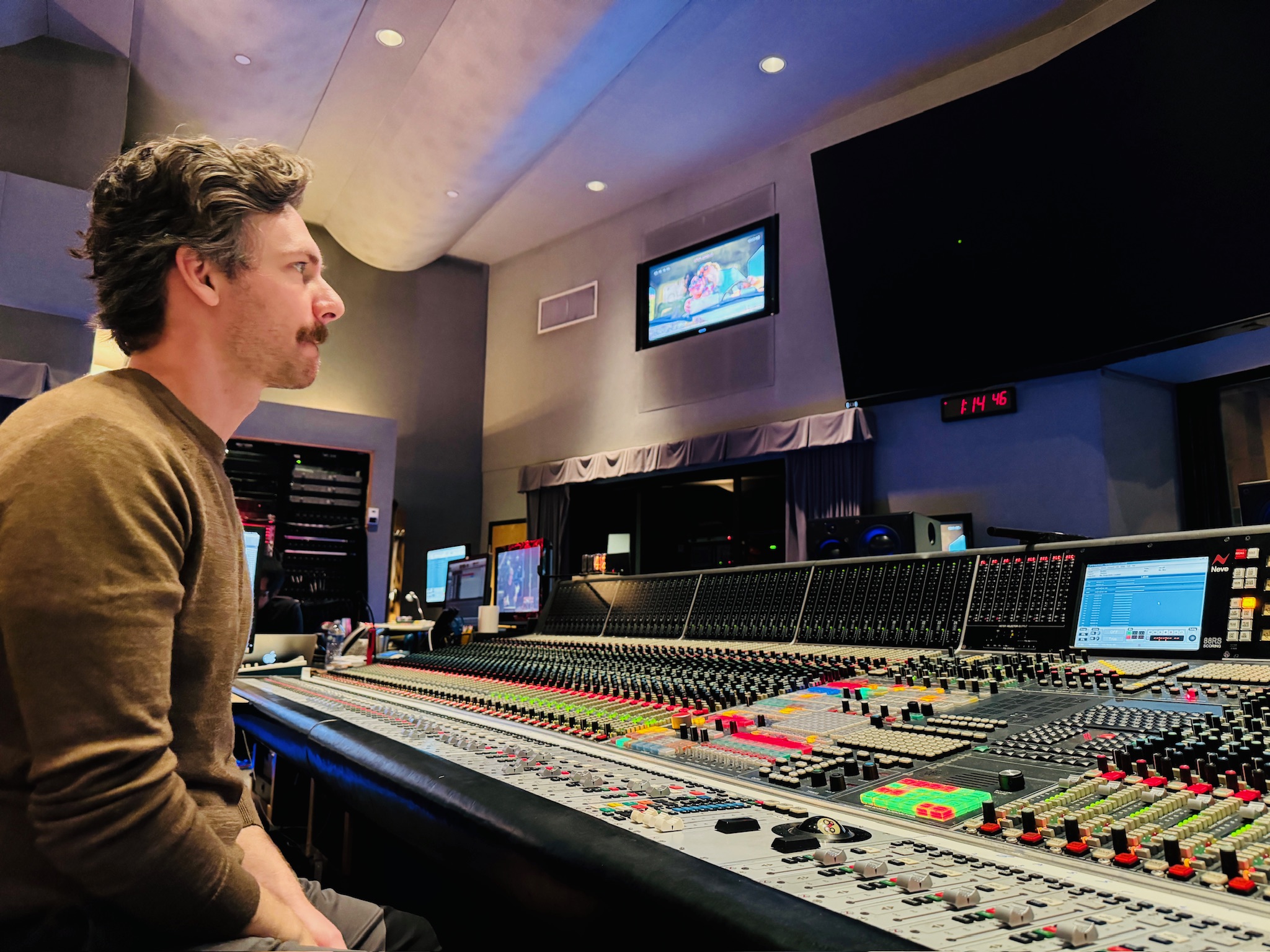 There seems to be quite a symbiotic relationship between composers and mixers, do you find that when working with John, you’re both bouncing off each other as you’re working on projects?
There seems to be quite a symbiotic relationship between composers and mixers, do you find that when working with John, you’re both bouncing off each other as you’re working on projects?
Yeah, definitely. It’s a lot of trying to figure out how to get things to just sit right in the mix and a lot of times, depending on how it was composed, it kind of just falls together where you really feel like you don’t have to do a lot of work because you throw up the dialogue and the sound effects and I don’t even have to touch the overall fader much because it’s all just been orchestrated to the point of just being correct for the film.
I’m guessing that if it’s been well recorded and well composed and arranged, then it makes your job incredibly easier?
Yeah, and that’s one of the things about John is that he’s done this for so long he knows what’s going to work and what’s not going to work. Whenever it comes to listening to things he can quickly say, ‘what’s that muddying it up? I know it’s not the mix, I know it’s the arrangement’ and he’ll say ‘let’s mute it’. And other times, it’s like, ‘I can tell that this is going to work, but we need to work on the mix a little bit’. Then I’ll sit there and I’ll do a little more EQing and I’ll see what I can do. Sometimes you have the demo to listen to, but after you get the live elements in sonically, things start to take shape a little more so there might be things where you hear certain instruments at certain levels in the demo and you think, ‘okay, that really needs to be a lot louder’. You mess around with stuff and you think, ‘maybe that’s working’, but then, in the mix review process, you end up finding out, maybe that can actually come down some and we can use a little bit more of this thing. It is a bit more of a banter whenever it comes to that and trying to figure out what’s right for the mix.
Do you find you can second guess some of the things that he’s going to ask you for? Or a way a mix can go? Or is every day a school day?
Yeah, every day is kind of a school day. Always learning and always trying to figure out what the best way is to do stuff. Sometimes things just don’t always carry over from one cue to the next and a lot of times things don’t carry over from one score to the next. I know a lot of mixers who have their template and they use that template for every score they do. I haven’t found that I can get into that rhythm so my templates for every score are built from scratch. I’ll use a lot of the same plugins and I’ll start with a lot of the same settings but normally I start with everything in bypass and I just try to throw the faders up and get everything sounding the way it’s supposed to sound then I start adding plugins whenever I feel like I need to add plugins.
You’ve got a pretty eclectic catalogue, one minute you’re mixing M3gan, or Ice Age, the next you’re mixing the Michael J. Fox story, Still, which is a totally different kettle of fish. I guess they are totally different projects, in the sense of musicality and what the music is trying to do for that?
Yeah, they are. Michael J Fox was all overdubs, it’s like a drum set, guitars, organ, piano, bass, guitar, and a very small string ensemble, I think it was a quintet. And then we’ve got John’s film Migration that we did with Illumination (due for release in the UK in February 2024) and that was a huge fully orchestral score with tons of full orchestra strings and brass and winds and percussion. So yeah, it would be hard for me to use the same template on both of those scores.
It always helps to have an assistant to get me from point A to point B too, because I don’t want to spend a lot of my time prepping all of my stuff, and then just hoping that it sounds okay with the template that I have. I really lean on having an assistant to sit down and just start pushing the faders up.
It sounds like you thrive on difference, that if every day was the same, you’d get bored quite quickly. You enjoy jumping around between genres and different things. Would that be a good observation?
I think you’re completely right. I think the thrill of something new or just something changing – I want to hop around and do something different every time. I’m doing more films these days, and I will hopefully always continue to do film scores, but I want to do pop music too, I want to do country music, I want to do hip hop music to the best of my ability for the rest of my career.
I love to jump around and try different things and always keep it a little different. Every time I mix something, I always look back at it after the project and feel like it’s probably one of the worst mixes I’ve ever done.
Are you your own worst critic then?
Oh, probably so, yeah. In my professional life and probably in my personal life as well.
Do you watch the stuff you make, or is it too hard?
Oh yeah, I always watch it, because I have to judge it afterwards and I have to know what was working and what wasn’t working. It’s like with a sci-fi film, they’ll say, ‘I really want to hear the blinking of that doll’s eyes or something’, and you’re like, ‘well, there’s great music going on there. Why are we ducking the music so we can hear the thing at this rep?’ Then they pull the music down and you’re like, ‘Oh, if I could have anticipated that they were going to pull the music down there in that section, then maybe I would have pushed up the snare drum a little bit there because now I feel like I’m losing a little bit of energy or something like that.’ So I always have to listen.
Do you think you’re in the wrong part of the cycle then, in a sense? Do you feel like you should be further down the food chain?
Maybe, it’d be a dream to score and mix a film, and maybe one day I’ll get there once I have the influence.
What’s interesting is, in the movie world, the streaming service can mess up the sound of your mix. The movie theatre can. How often do you really hear what you mixed the way you heard it?
There’s all of these guidelines from Dolby and whoever certifies. You go to any theatre and it sounds different, either because of the acoustics or because of the speakers they’re using, or because of the layout of the room of where you’re sitting, or the way that the room is tuned or not tuned or calibrated or not calibrated. I’ve been able to get invited to screenings for the last preview for certain films and that’s always educational because I get to sit in the room with the producers and the composer, the sound effects editor and the re-recording mixer and get to talk to everybody and ask them what they thought of the music. What could I have done that would have made this better? What did you have to do to do this, or did you do any processing to it? Usually there’s no processing done, I’m fairly happy that people don’t feel like they have to EQ my stuff after I send it to them to make it work with the film.
It’s always education. It’s kind of like mixing music and everybody goes out to their car to listen to their music to make sure it’s not going to get screwed up in the real world. Everybody has to listen to it on headphones or something to hear how people are going to hear it in the AirPods or something like that.
Is imposter syndrome part of the perfection thing for you?
Oh yeah, definitely. I feel like I don’t know what I’m doing most of the time. I’ll get caught out and then that’ll be the end of me.
How do you deal with that? Have you got any strategies or do you just push on through?
Yeah, you just kind of have to push on through and hope you get another job afterwards. As long as I have a job to show up to, then I feel a little better about it. If I end up not having a job because of the work that I do, then that’s when I’ll really feel like I don’t belong somewhere.
Let’s talk about gear, do you have some kind of template so you don’t reinvent the wheel every time you come to do mics?
Yeah, I do have a template. It’s a fairly simple template and normally consists of an aux master with one or two plugins. Normally it’s just an EQ, sometimes a compressor and then maybe a harmonic exciter or something like that for each stem. Then it comes down to having three to four different reverbs and then a delay and then an upmixer, a low frequency extender and that’s really it. Then I have what I like to call my synth master or my prelay track templates where it just has a bunch of EQs and all of the sends to each stems, effects returns, that I need to have on all of the prelays that are all just bypassed and inactive and ready to be enabled whenever I want to use it.
Each has its own thing, like stuff in the strings will have different EQs than stuff in the bass stem, than stuff in the percussion stems. I try to keep it a little bespoke, but I always keep it bypassed and inactive until I’m ready to use it.
I guess most of the stuff you get to mix is pretty well recorded because it’s John’s stuff. How are you using reverbs in your template?
For verbs I use a mixture of things. It really depends on what the source material is that I’m trying to use verb on. For instance, strings, if they’re live strings and they’re recorded, say we’re mixing in Atmos, like a 7.1.2 type of thing and I’ve got something that was actually recorded in 7.1.2, then I really like to use LiquidSonics Seventh Heaven, as I’m sure probably most score mixers like to use.
I was feeling like the verbs were a little thick for that because of the way that Seventh Heaven was doing the propagation – you send something to the left channel and you can control the cross feed so I was having it with -6 dB of crossfeed so then the left source is coming in at whatever level and then everything else on all of the other nine channels are coming in at -6 dB down. But I was still feeling like stuff that was panned directly to the left or directly to the side, I didn’t necessarily want spilling over to the right side or to the right rear or to the right speaker because I’ve got all of those microphones in the room already.
I kind of wanted something a little thinner so I talked with Matt at LiquidSonics about propagation and how reverbs propagate their material and that it might be helpful to have a left side propagation and a right side propagation, which Matt very kindly implemented for me in one of the latest updates (Cinematic Rooms 1.2.8 and Seventh Heaven v1.4.7). You can turn that on in the settings and then you send something to the left speaker and then it only propagates in the left side and the right rear and the top channels. Then if you pan it to the right side then it only propagates in the right side of the spectrum. It feels like it retains that integrity of this stuff. I really want to be focused on the right side, so let’s keep it on the right side and maybe not blend it too much to that side because I’ve already got the room doing a ‘room thing’ as well. But then if we go to a stereo thing that’s a prelay, maybe it’s a prelay synth or something like that, it’s nice to keep the propagation to all speakers because then I can really upmix it into the room. I can use an upmixer, something like the Nugen Halo upmixer that will upmix it to and then I can mix that in with the wet signal from some of the reverbs and stuff.
Cinematic Rooms has become an industry standard. Are you using that much in your mixes?
Yeah, I do. That one I’ve been playing with and changing out with the Symphony 3D from Exponential Audio, I’ve been going back and forth and testing them. Normally, I have both of those on the same track and it turns into an either/or situation for me.
It’s [Seventh Heaven] kind of nice and it gives you a little something that helps things pop out a little bit, like maybe adding a little chorus or something to a vocal. A lot of times what I’ll do, especially with strings and orchestral elements, is I’ll send it to two different reverbs, like Seventh Heaven and either the Symphony 3D or Cinematic Rooms Professional and I’ll just mix a blend of those to be my template for the rest of the score.
And then does a little bit of everything get fed into that or just bits of the orchestra?
Bits of the orchestra, I’d say mainly the room and sometimes a close mic from the strings every now and then, depending on how much of the close mics that I’m using.
Is that just to give it a bit of a lift, a bit of a sheen?
Yeah, a bit of a lift, a bit of a sheen, and it depends on the room that it was recorded in as well. If it was recorded at Air Studios, Air’s got such a big and long tail that a lot of times it either doesn’t need reverb or it just needs a little bit of reverb. If you’re recording at a drier place like Sony or Fox or something then you’re leaning into that reverb a lot more.
Are you using reverb as an effect as well from time to time on some of the big synth sounds?
Yeah, I’ll use reverb as more of an effect for that, to give it a little more movement, make it feel a little more interesting. I’ve recently, on one or two scores, started using Tai Chi. I recently tried it on some guitar stuff that I was doing and I was getting some pretty cool stuff out of it. I always have to be careful with reverbs doing certain things because I’m almost always mixing in Atmos, especially for film scores and so I run into CPU problems a lot and I almost always mix at 96k. So with Tai Chi, if I end up using too many of those I start running into CPU problems so I always have to be very cognizant of what I’m using and I have to do things very purposefully whenever I’m doing that.
I try to make sure that everything is targeted and that I’m doing something for a specific reason rather than just throwing something up and hoping it works and then just leaving it on.
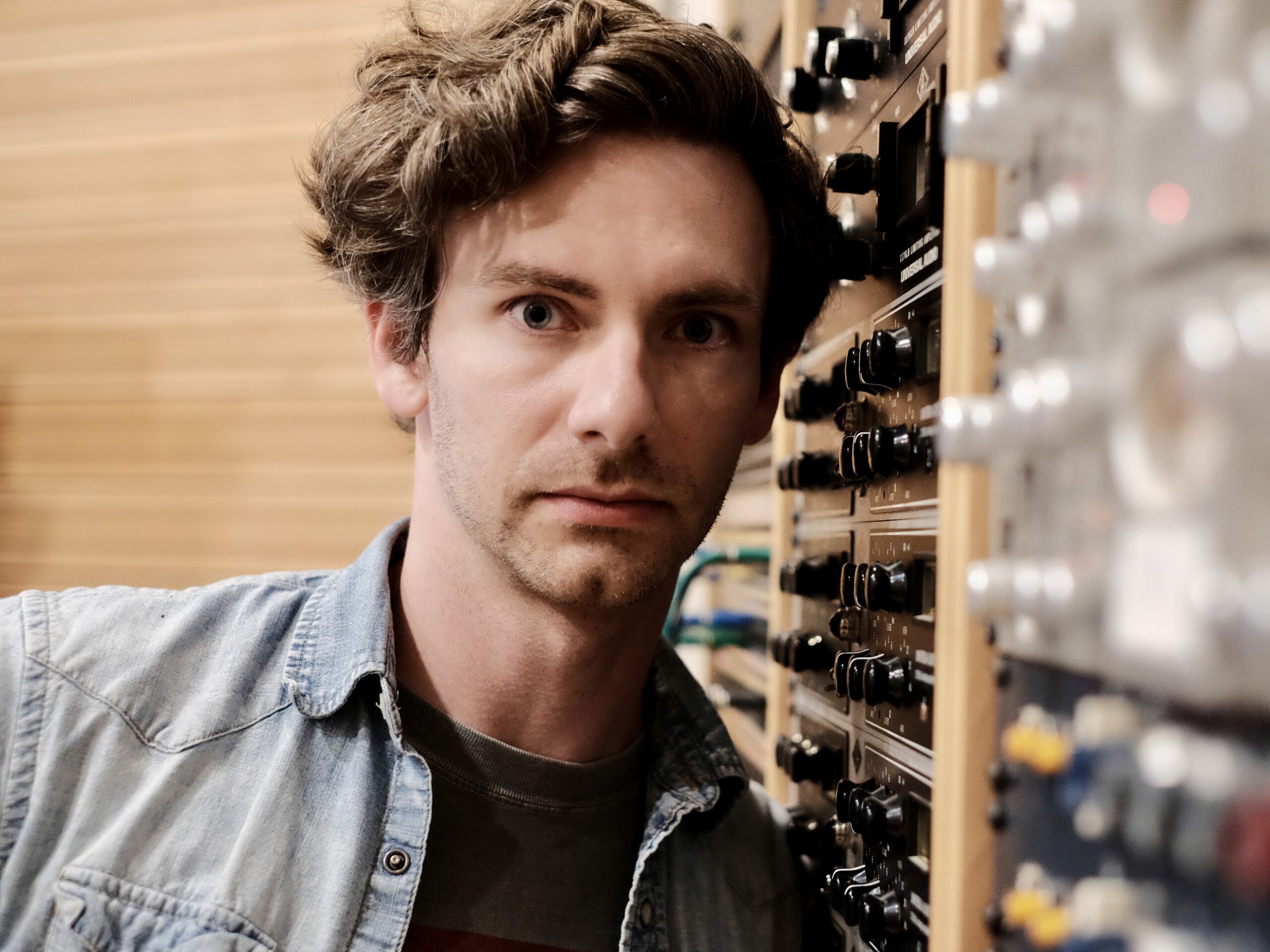
Have you had a play with the reverb multipliers in Tai Chi, where, let’s say, everything from 5-10k suddenly got twice the decay time as something that’s below it and stuff. Have you played with that yet?
Yeah, I have played with it a little bit. I found that whenever I do use Tai Chi, although sometimes I use it as a 7.0.2 plugin for my Atmos, a lot of times it’s a little more effective and CPU friendly if I use it on a stereo track and then I just mix it in with the wet or the dry and that always is a lot more useful and that really helps. The multiplier stuff is really great, the only issue with it is that it just takes up so much CPU and that’s why I use it a lot as my overall template reverbs, but it does make it into a random, “oh, let’s play around with something and let’s see if we can get a fun sound coming out of this”.
Do you do much stuff with plates?
Yeah, I use plates a bit. Drums normally get a little plate on there, sometimes vocals depending on what it is and maybe a guitar here and there too. I don’t use plates often on orchestral elements unless it’s percussion but I do use plates a lot, that’s actually my go-to plate [Lustrous Plates] because that’s the only one I found that actually does Amos as far as I know. It’s pretty impressive the way that it sounds, and it gets a really great plate sound, it’s super useful.
That’s probably my go-to plate for guitars, that’s open all the time and is used quite often. I’m always trying to find the best preset and fiddling around with it to get the best sound for guitars on every score where I have guitars, which is probably most scores these days.
Do you have a favourite plate?
I can’t say that I have a favourite. I think Beryllium is the one that just happens to be the first one in my template and it’s the one that’s there whenever I open up the plugin, but it changes a lot depending on the guitar that’s being played and what the part is and what the rest of the score is doing, so I can’t say that I have a go-to because it always changes. It’s probably the only plate that I use right now, honestly.
Given your journey to date, what bit of advice would you give to your 17 year old self?
I guess the advice would be just do it. Take everything that everybody says with a grain of salt because I feel like I’ve been told a lot of things that didn’t actually mean anything. You just have to do it and you have to be willing to persevere through a lot of different experiences.
You’ve got to work really late nights and you have to be willing to go out and find your own work. It’s really tough to get into the music and film industry, it’s a very small world so it’s hard to get in. For a lot of people, they’re not accepting of new people coming in and they want to keep their secrets close to their chest. They don’t want to hand out their techniques and stuff so you really have to slowly work your way in. I would just say persevere and don’t take no for an answer.
Try LiquidSonics Reverbs For Yourself
LiquidSonics reverbs are fast becoming the industry standard for score mixers, but if you’re yet to hear one for yourself it’s easy to audition them for your workflow as every LiquidSonics reverb is available to try for 14 days. So if you’re curious about the reverbs everyone’s talking about just head to our demos page to drop a code into your license manager and pick up the installers from the downloads page.

